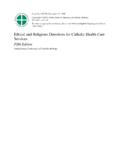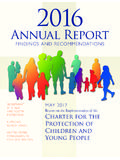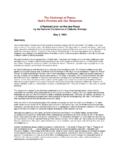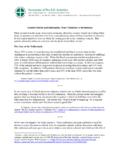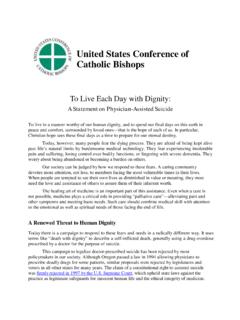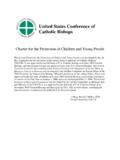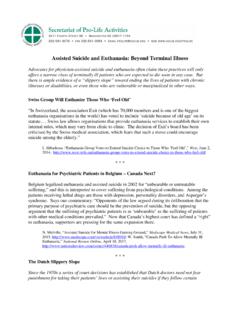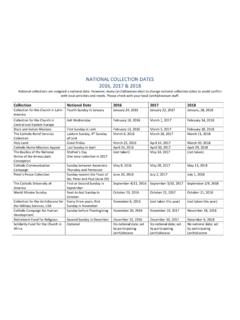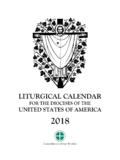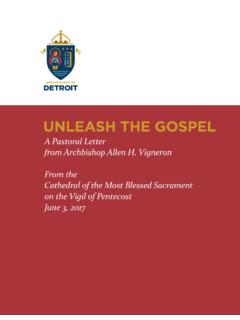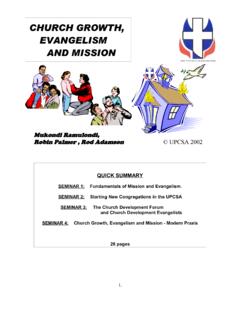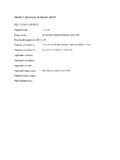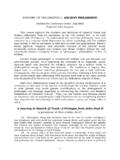Transcription of THE PERMISSION TO PUBLISH
1 THE PERMISSION TO PUBLISH . A Resource for Diocesan and Eparchial Bishops on the Approvals Needed to PUBLISH Various Kinds of Written Works Committee on Doctrine United States Conference of Catholic Bishops The PERMISSION to PUBLISH A Resource for Diocesan and Eparchial Bishops on the Approvals Needed to PUBLISH Various Kinds of Written Works Committee on Doctrine United States Conference of Catholic Bishops The document The PERMISSION to PUBLISH : A Resource for Diocesan and Eparchial Bishops on the Approvals Needed to PUBLISH Various Kinds of Written Works was developed as a resource by the Committee on Doctrine of the United States Conference of Catholic Bishops (USCCB). It was reviewed by the committee chairman, Archbishop William J.
2 Levada, and has been author- ized for publication by the undersigned. Msgr. William P. Fay General Secretary, USCCB. Excerpts from the Code of Canon Law: New English Translation. Translation of Codex Iuris Canonici prepared under the auspices of the Canon Law Society of America, Washington, 1998. Used with PERMISSION . Excerpts from the Code of Canons of the Eastern Churches: New English Translation. Translation of Codex Canonum Ecclesiarum Orientalium pre- pared under the auspices of the Canon Law Society of America, Washington, 2001. Used with PERMISSION . First Printing, June 2004. ISBN 1-57455-622-3. Copyright 2004, United States Conference of Catholic Bishops, Washington, All rights reserved. No part of this work may be reproduced or transmit- ted in any form or by any means, electronic or mechanical, including photo- copying, recording, or by any information storage and retrieval system, with- out PERMISSION in writing from the copyright holder.
3 Contents Introduction.. 1. THE PERMISSION TO PUBLISH . 1. Where is the pertinent canonical legislation on the authorization of books and other writings to be found? .. 2. 2. What forms does ecclesiastical authorization take? .. 2. 3. Which writings require authorization in the Latin Catholic church ? .. 3. 4. Which writings require authorization in the Eastern Catholic Churches? .. 5. 5. Which writings lie beyond the jurisdiction of the local ordinary or hierarch for the granting of the requisite authorization? .. 7. 6. Who may grant the authorization for written works? .. 7. 7. What qualifications ought diocesan and eparchial bishops to consider when appointing censors to review writings requiring PERMISSION or approval? .. 9. 8. What criteria are censors to use when reviewing works submitted for ecclesiastical authorization?
4 10. 9. What options are presented to the local ordinary or hierarch following receipt of the censor's written evaluation? .. 10. 10. How is the authorization to appear in the published text? .. 11. 11. What does ecclesiastical authorization imply for authors, readers, and publishers of written works? .. 12. 12. Does the authorization apply to subsequent editions of the written work? .. 12. 13. What remedies exist in law in the event that a request for authorization has been denied? .. 13. 14. What is the appropriate process to be followed in the event that a local ordinary or hierarch determines that a previously granted authorization should be withdrawn? .. 13. Conclusion .. 15. NOTES .. 16. APPENDICES. Appendix 1: Code of Canon Law (1983).
5 23. Appendix 2: Code of Canons of the Eastern Churches (1990) .. 26. Appendix 3: Congregation for the Doctrine of the Faith, Instruction on Some Aspects of the Use of the Instruments of Social Communication in Promoting the Doctrine of the Faith (March 30, 1992) .. 30. Appendix 4: Sample Precept Enjoining a Person or Entity to Submit Written Works for Ecclesiastical Authorization .. 40. Appendix 5: Sample Rescript Granting Authorization to a Work Pertaining to Faith or Morals in the Latin Catholic church .. 41. Appendix 6: Sample Rescript Granting Authorization to a Work Pertaining to Faith or Morals in the Eastern Catholic Churches .. 42. Appendix 7: Sample Decree Withdrawing Ecclesiastical Authorization Previously Granted to a Written Work.
6 43. Introduction T. he diocesan or eparchial bishop is, for the people entrusted to him, a source of unity within the diocese or eparchy and an authoritative teacher of the faith. The responsibility of authorizing written materials that treat questions of faith and morals is one aspect of the bishop's unique role as pastor and teacher, and an important way in which he exercises his supervi- sory function over the ministry of the In a November 1990 circular letter to the presidents of the episcopal confer- ences, Cardinal Joseph Ratzinger, prefect of the Congregation for the Doctrine of the Faith, set forth several matters relative to the functioning of episcopal conference doctrinal commissions. One of the essential responsibilities of these commissions, he noted, is to provide assistance to each bishop in the task of monitoring and evaluating theological works (books and reviews) published in his territory.
7 2. In fulfilling this aspect of its mandate, the Committee on Doctrine of the United States Conference of Catholic Bishops, working collaboratively with other con- ference committees, has prepared a concise resource that summarizes the church 's legislation on the authorization of certain This resource is being offered as a service to diocesan and eparchial bishops in the further exercise of their teaching ministry. The PERMISSION to PUBLISH 1. The PERMISSION to PUBLISH 1. Where is the pertinent canonical legislation on the authorization of books and other writings to be found? The church 's norms on the authorization of books and other written materials are found in two primary sources: the 1983 Code of Canon Law (CIC) for the Latin Catholic church , canons 822-832, and the 1990 Code of Canons of the Eastern Churches (CCEO) for the Eastern Catholic Churches, canons 651-666.
8 In addition, a 1992 Instruction from the Congregation for the Doctrine of the Faith defines and makes explicit the processes by which the canons of the Code of Canon Law are to be (See Appendices 1-3 for a reprint of these materials.). 2. What forms does ecclesiastical authorization take? In the Latin Catholic church , there are two primary forms of ecclesiastical authorization for written works. These are identified in church law as per- mission (licentia) and approval (approbatio). Since these terms are not used consistently within the various authoritative documents, a consensus has not yet emerged among canonical experts as to whether the terms are interchange- able or whether there is, in fact, a precise and practical distinction between the two.
9 The term imprimatur is not used in the law for the Latin Catholic church to express either licentia or approbatio. A third form of authorization identi- fied in the Code of Canon Law is the concordantia cum editione approbata ex attestatione, which is granted by local ordinaries to signify that reprints of liturgical books, their translations into the vernacular, or their parts are in con- formity with the church 's officially approved editions of liturgical In the Eastern Catholic Churches, three primary levels of ecclesiastical authoriza- tion are identified in canon law. These are PERMISSION (licentia), approval . (approbatio), and praise or blessing (laudatum vel benedictum).6 A fourth form of authorization identified in the Code of Canons of the Eastern Churches is the concordantia cum editione approbata ex attestatione, which is granted by local hierarchs to signify that reprints of liturgical books, their translations into the ver- nacular, or their parts are in conformity with the church 's officially approved edi- tions of liturgical (See Question 11 below for additional information on the implications of these various forms of authorization.)
10 2 The PERMISSION to PUBLISH 3. Which writings require authorization in the Latin Catholic church ? Canon law does not require that all writings produced by Catholics receive ecclesiastical authorization. One of the first determinations a diocesan official must make upon receiving a request, therefore, is whether the work submitted requires further action. Only those works specified in law need be authorized. In making the appropriate determination, four characteristics about the text ought to be considered: a. Is the work in written, printed format? The Code of Canon Law defines what is to be understood by the term books for the purpose of obtaining ecclesiastical authorization within the Latin Catholic church . Those things established regarding books in the canons.
